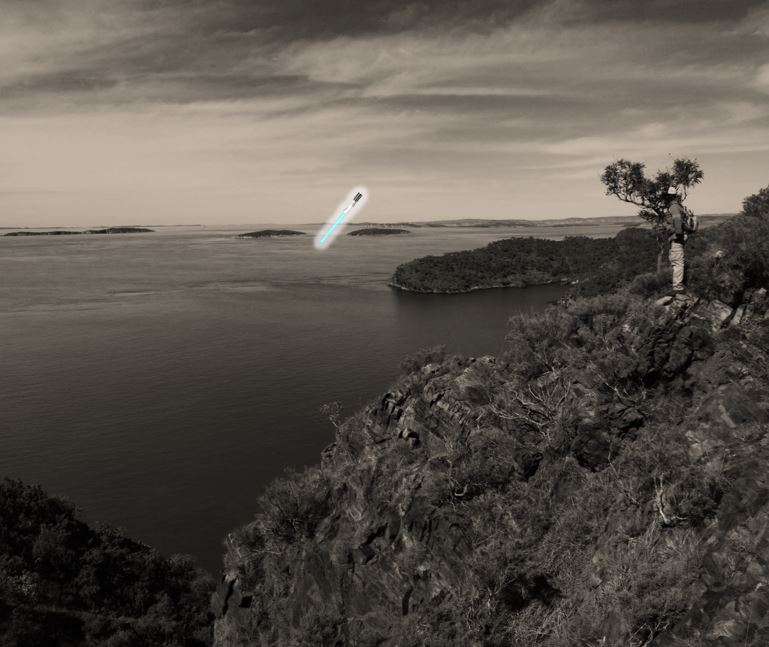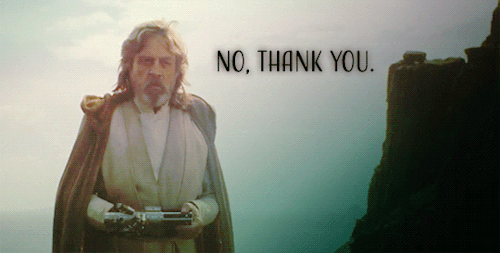“What is it?”
“It’s your father’s Lightsaber. This is the weapon of a Jedi Knight. Not as clumsy or random as a blaster. An elegant weapon, for a more civilized age.“
―Luke Skywalker and Obi-Wan Kenobi
On the road to becoming a Jedi a Padawan is expected to build their own Lightsaber. The Lightsaber is more than a weapon it is an extension of the Jedi. The form, color and design of the Lightsaber reflects the character, persona and qualities of the Jedi wielding it. The Kyber crystals that provide the heart and power of the Lightsaber are earned through the ingenuity and resolve of the Padawan. The crystal chooses the Padawan through attraction. In many ways the Lightsaber is the Jedi and the Jedi is her Lightsaber. The Jedi wields the Force through the blade of the Lightsaber.
In “The Force Awakens”, Rey finds Luke Skywalker’s long lost Lightsaber. The same Lightsaber wielded by Anakin. Learning the location of the missing Jedi Master she finds him at the ancient Jedi Temple on the planet Ahch-To. In the last scene of the movie Luke is looking out over the ocean and turns to face Rey. The Jedi Master has aged and his eyes are wise but it is still the Luke Skywalker of old. Rey holds out the Lightsaber in front of her and he looks at it and then at her. The scene fades and the movie ends. The moment was memorable and spell binding. Luke is found and reunited with his Lightsaber, an indelible part of his history. The hero’s Journey begins to blossom once again.
The WTF moment
Fast forward to “The Last Jedi” and we find Luke and Rey still standing on the rock overlooking the windswept cliffs. They face each other. Luke takes the Lightsaber from Rey’s hand looks at it and then tosses it behind his back without a saying word. Rey stands speechless and watches the Jedi Master she has heard so much about, the Legend, storm off. I watched the scene unfold completely stunned as millions of others around the world did. Why would Luke do something like that? Was he mad?
I began to ponder that question over the months after I watched “The Last Jedi”. There have been many theories that have been raised online as to the cause of Luke’s actions. Some said that he was disillusioned with the Jedi Path and had turned in to a grumpy old crank and shut out the Force. Others thought that he had embraced a philosophy of non-violence and no longer required a Lightsaber.
I then began to explore the personal relationship between Luke and the Lightsaber in an attempt to understand the scene. If my personal conclusions satisfied me, then perhaps I could derive some philosophical meaning that could be applied in my life as a Real World Jedi. The story arc would have then served a purpose as Mythology should; to use story telling in explaining the world and passing on life lessons.
Luke Skywalker never built his first Lightsaber as Jedi normally do. He inherited his father’s, Anakin’s Lightsaber. In “A New Hope” Obi-Wan Kenobi presented Luke Skywalker with the Lightsaber. In the same scene he revealed to Luke that his father was a great Jedi who had been killed by Darth Vader. It was a defining moment in the entire Star Wars saga but the significance was barely noted. By handing Luke his father’s Lightsaber, Obi-Wan handed over a legacy and ignited a flame that would eventually grow in to an inferno that was ultimately felt across the Galaxy.
No, I’m your Father
Luke carried the Lightsaber in many battles and trained with it on Dagobah. The Lightsaber eventually had an unexpected ending. Luke lost it when his hand was removed during the infamous Lightsaber duel with Darth Vader on Bespin in “The Empire Strikes Back”. As Luke grappled with the grief of losing his treasured heirloom and the pain of losing his hand his world was further shattered. With impeccable style and timing, Darth Vader put some important untruths to end. Obi-Wan and Yoda had been lying along along and the man Luke thought had killed his beloved Father was in fact his Father.
What a way to end a very bad day.
The heirloom was Luke’s destiny but it was not his Lightsaber. Luke did not find the Kyber crystal through his own trial. The Lightsaber had not been forged, built and wielded solely by him. In essence the Lightsaber still belonged to Anakin. It was an orphan. Obi-Wan had given him the Lightsaber and perhaps that was the Force at play or pure emotional manipulation. The heart of the Lightsaber still belonged to Anakin as much as Excalibur belonged to King Arthur and the sword Anduril belonged to Aragorn in the “Lord of the Rings”.
The loss of the Lightsaber on Bespin was undoubtedly a good thing. Luke was better off without it. The Lightsaber held within it the essence of the fallen Jedi, his Father. Every stroke and battle, every emotion of loss, pain, anger, hate and fear which Anakin had been through was tied to the Lightsaber. Luke could pick up the Lightsaber and use it. But ultimately he was wielding a tool that had inflicted suffering. The blade been used to massacre innocents including the Younglings at the Jedi Temple when Anakin was turned by Palpatine. Had Darth Vader said his famous “I’m your Father” line while Luke still had his hand I have no doubt the Lightsaber would have been tossed in to the void in a reaction of revulsion and horror.
“Where is your lightsaber, Lord Vader? Use its power! Defend yourself!”
“Lost in the fight with… Obi-Wan. He…took it.”
“That blade belonged to another. A Jedi. You are a Sith.“
―Darth Sidious and Darth Vader
The Baton of Guilt
This makes me wonder if Obi-Wan Kenobi and Yoda were not a little irresponsible if unethical for withholding intimate truths from Luke and not disclosing the dark past of the Lightsaber he wielded. No doubt the truth would have been too great for Luke to bear. Perhaps both Jedi Masters were terrified that the chosen one would fall like his Father if he knew. They did what they had to do.
Luke did build a Lightsaber and it first appeared in “Return of the Jedi”. The Lightsaber would ultimately bring Darth Vader to his knees. The weapon became an extension of Luke. It carried his very essence but like his Father’s before him it also carried his fear and doubts.
Many years later in a moment of insanity Luke ignited his Lightsaber over his sleeping nephew Ben Solo. Luke had sensed a dark evil in his apprentice and in revulsion reacted with anger. Ben awoke and in his rage joined the Knights of Ren and became Kylo Ren. Later he destroyed the second Jedi Temple. Racked with guilt, Luke fled in to self-imposed exile deserting his family and friends.
Anakin’s long lost Lightsaber was found again decades after it had been lost in the Cloud City. The vision of it had appeared to Rey in her dreams. There was a connection. On the Planet of Takodana it hid and when by fortune or fate Rey found herself there in the very castle it lay hidden, it called to her and she took it up.
Later Rey used the blade in battle against Kylo Ren. The Force awakened, she wielded the Lightsaber with the skill of an experienced Jedi during the assault on Star Killer Base. Learning the location of Luke she traveled to Ahch-To and there returned the long lost Lightsaber to Luke. This was the very moment millions of fans had waited decades to see. Luke would at last take his Lightsaber like Aragorn took up Anduril and reclaim his destiny.
Wouldn’t he?
Credit: SW-daydreamer.tumbler.com
No he would not.
“When I left you, I was but the learner; now I am the master” – Darth Vader to Obi-Wan
Letting Go
Luke tossed the treasured heirloom off a cliff.…As shocking as that appears who can blame him? I can’t. Luke by now would have learned the full tragic story of his Father and Mother. The Lightsaber had its own story. It had been wielded for good and evil but ultimately it was tainted. I would not want such a reminder of a dark and painful past in my possession. Although an object can neither be viewed as “good” or “evil” on its own there is no denying that as humans we do attach associations, memories and stories to objects that give them a tone of “light” or “dark” and “good” or “evil”.
Alcoholics carry such a legacy of guilt. This is why making an inventory of faults and wrongs is so important. By confronting our dark past we can acknowledge the harm we have done to self and others. Sharing that burden with those we trust and a Higher Power gives us the strength to let go of those faults and finally “turn them over”. The guilt and shame dissipates. Forgiveness and amends sets the past right and allows us to move on with our lives free from past mistakes. We are no longer hostages to our past and tethered there emotionally and spiritually.
Given a few years of recovery you look back and no longer recognize the person you once were. The selfish Drunk of the past becomes as complete stranger. We would not go back even if we were promised heaven on Earth. That person, that past is nothing to us now. We have tossed that part of us over the proverbial cliff.
“This one is mine. I no longer use yours.“
―Luke Skywalker, to Darth Vader
The Unwanted
There is the possibility that Luke discarded the Lightsaber because he no longer attached any value to it. The Lightsaber was now simply a tool that provided no use to him. Given his utter indifference on seeing the Lightsaber held up to him it may have been possible that he simply rejected the return of his Lightsaber for no other reason than it was mere junk to him. Luke felt nothing for dusty heirlooms. The past was dead to him. It was nothing to him.
People evolve and grow and the things that were important to us in the past might not hold any value in the future. No matter what significance or meaning we attach to things, they are still things and nothing more. It is the perception in our mind of the thing which elicits attraction or revulsion. People fall out of love with things as often as they fall out of love with other people. Ideas and beliefs are no different. We are not tied to them and compelled never to challenge, revise or dismiss our ideas, biases and beliefs.
There is the final possibility that Luke recognized Rey as his pupil although he resisted it. Luke may have sensed that the Lightsaber was no longer his, but now hers. Rey was exasperated by Luke’s cantankerous and dysfunctional antics on Ahch-To. What if Luke’s antics were nothing of the sort and simply intended to throw Rey completely and test her? After all did Yoda not play “games” with Luke on Dagobah? Anything is possible.
The Jedi Master reminded me of an Alcoholic who had been sent to rehab on a desert Island where there was no possibility of him getting any access to booze. Rey hands him his Lightsaber in the scene in “The Last Jedi” and there is a brief flicker of hope as if a stranger has bought him a bottle of Chivaz. When Luke looks down and sees its no malt whiskey in his hand but a Lightsaber he throws it behind his back in disgust and disappointment and skulks away to his hut to cry. That’s what I would have done back in the day.
Rey’s first reaction was to retrieve the Lightsaber and begin training with it. It may have been rejected by Luke but she saw purpose in it. Unbeknownst to her she had claimed a legacy which spanned more than half a century. Rey held in her hands a weapon which carried immense history and no doubt carries a purpose in the final conclusion of the Third Trilogy. There is the real possibility that she was meant to have it. The Lightsaber had become her destiny.
“Luke, we are what they grow beyond. That is the true burden of all masters.” – Yoda
Memories
The relationship between Luke and his father’s Lightsaber is in many way an analogy of the relationships that people have with their past including people. If someone walked up to me and handed me my alcoholic past I would probably recoil and cast it aside as readily as I would reject the offer of a drink. For decades I tried to forget the first 18 years of my life and used booze to help. I own nothing from my childhood, not even a photo as a result. I threw away all mementos of that past away.
I don’t know if I could have faced my Father again when he was alive because of those painful memories. For more than 25 years we never spoke or saw each other again. I had shut him out utterly. I’ve since made amends and forgiven him although he died before I had the chance to do it in person. That’s all I can do.
I know my past and at times I glance there when it serves to remind me of what I was but I avoid staring too long. Memories can be painful and sometimes we want to be rid of not only the memories in our minds but also the physical reminders of them. At some point we have to accept and move on.
Heirlooms are there to remind us of where we come from. They are passed from generation to generation and as long as they hold significance they are kept and treasured. Once things lose their meaning, they lose significance and they are thrown in the attic or end up in a garage sale. Luke simply rejected that symbol of his past by tossing it off a cliff. So it is with versions of ourselves. As humans we are made to shed older versions of ourselves, let go of old ideas and grow. Growth can be painful. When we were little children our bones lengthened and we ached and cried in pain. As we grow older it is the shedding of old ideas and habits for the new which is sometimes painful. It means the treatment is working, we are growing as a person.
I never forget where I came from and how I got to where I am. By confronting the past rather than ruminating on it I never forget what I need to do. I remind myself of the consequences should I fail. By learning rather than regretting we train ourselves to stand strong and resilient rather than being passive in self-pity and remorse. I have tossed the old Lightsaber of an alcoholic past over a cliff in the journey to be a better version of myself.
“I see you have constructed a new Lightsaber. Your skills are complete. Indeed you are powerful, as the Emperor has foreseen.“
―Darth Vader examining Luke Skywalker’s Lightsaber.
The Lightsaber Project
When I got sober I began building my new Lightsaber. It remains a lifelong project and is a metaphor for a Good Life. The goal is to continuously improve upon the old design to make something better. Aiming for but never reaching perfection.
The component parts of the Lightsaber are values and principles I have collected over time. Some of those parts have been upgraded and replaced as they wore out or were no longer in harmony with the rest. The assembled Lightsaber represents the combination of virtues I demonstrate. The Kyber crystal holds in its core the spiritual heart and soul of my Lightsaber. The form of the Lightsaber is the product of martial and physical training. The weapon within my hands feels light, agile, confident and strong. I know it is my own Lightsaber, a reflection of me. I have built from the wreckage of the past and the trials of my own life.
In “The Last Jedi” Rey carries the broken Lightsaber on to the Millennium Falcon. The weapon was broken in two halves as Kylo Ren and Rey used the force to each claim it. As the Lightsaber split exposing the Kyber crystals the it exploded as the Force held within was released. Rey managed to grab the weapon and flee.
We don’t know yet whether we have seen the last of Anakin’s Lightsaber but my guess is that Rey will rebuild it in to something new and more powerful.
Each of us struggle with our own “Light” and “Dark” sides. Those two halves that perpetually struggle for ascendancy within our ego. Many who suffer from addiction fight a daily struggle between attraction and aversion, light and dark. Over time one side eclipses the other and the result is either recovery or relapse. We ultimately choose which path to take. A broken Lightsaber can be repaired and a lost Lightsaber can be replaced with one that is better. Life is no different, wear it like a loose cloak and be prepared to toss out the old for the new, pick up the pieces, rebuild, replace, learn and finally move on.



